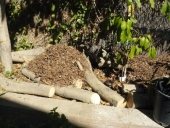In four years the only diseases or problems we've had was: one kid with pneumonia. Classic cause of 100+ temps with high humidity when she was less than a week old. She's 100% healthy after a round of Tylan. One other goat had a high worm load when she arrived at our place and we gave her a single dose of chemical dewormer and now she's fine. Those were the only times I've ever treated my goats for anything. They're all super healthy.
According to several authors, and also my own experience, if goats get all the minerals they need they don't get worms. Trees and tree trimmings are high in minerals so they get everything they need from the leaves and bark. Goats run best on low energy/high mineral/ high volume feed. Trees and brush provide the correct balance, supplemented with some pasture plants like perslaine, plantain, wild radish, fennel, mule fat, Ox tonge, etc.
Bringing in tree trimmings also allows me to vary their browse more than I could with pasture or any standard ration. Goats are browsers, not grazers. When goats browse in my system they go over the trees for a few days, then move on. They won't touch food that hits the ground - they are extremely picky that way. Once it's on the ground I muck it into the compost bin. I provide mangers for the trees along the perimeter fences so they're easy to load and clear out, and so the goats don't soil their own food (which they then won't eat).
Compare that to grazing. Parasites climb up the grasses, especially wet/damp grass. When goats and especially sheep eat the grass they can ingest a high level of parasites. Goats should always have a manageable load of parasites in they're system; you never want to eliminate them all. Browsing keeps the balance; grazing overloads them.
And unlike eating rich pastures, goats never colic on trees.
Once every few weeks I sprinkle a handful of DE over the supplemental flake of alfalfa I give to my animals. When they're out browsing they eat 'toxic' plants like tobacco and eucalyptus and caster in small amounts to naturally de-parasite themselves. So I guess that was a very long answer, but no, I don't really do much for parasite control as we have no parasite problems.








